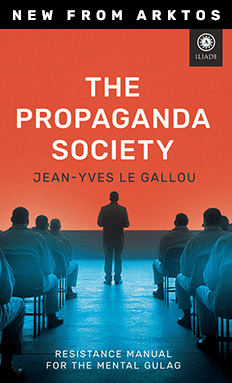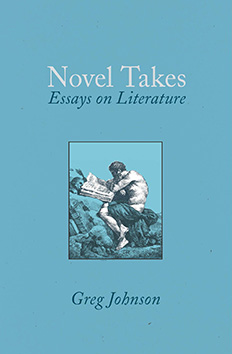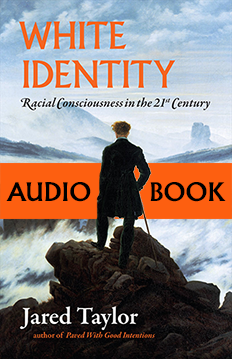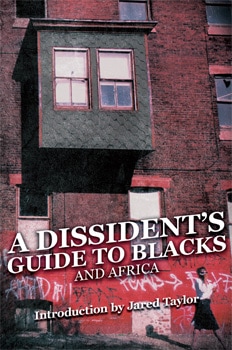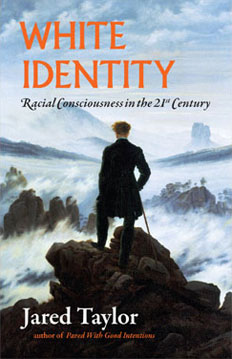The Constitution Was Written for Whites
Gregory Hood, American Renaissance, June 27, 2025
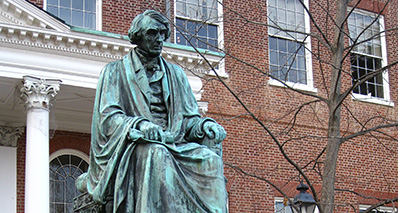
Chief Justice Roger Taney (Credit: Rudi Riet, CC BY-SA 2.0, via Wikimedia Commons)
American “conservatives” have two blind spots: They refuse to understand the importance of race, and they have an almost idolatrous love of the US Constitution. Now, a remarkable paper by a law student at the University of Florida explains that a proper understanding of the Constitution requires an appreciation of the importance of race.
In just 20 pages, Preston Terry Damsky argues that the primary source of the legitimacy of the Constitution is not in its language, but in what gave rise to: the sovereignty of the people. Furthermore, “the people” is not just whoever happened to be living here, but the particular people who established a nation-state by means of the Constitution. “National conservatism posits that, regardless of certain textual provisions with a seemingly open ended scope of application, the Constitution’s establishment of a nation-state under the sovereignty of the People must be considered its paramount purpose which may not be permissibly undermined by any governmental acts or omissions absent the direct and unambiguous consent of the People.”
Mr. Damsky argues that originalist interpretations must rely either on what legislators meant when they wrote laws (“original intent”) or what an ordinary speaker of the language would have understood (“original public meaning”). The latter allows a more objective understanding. Mr. Damsky says that the Preamble clearly states that “We The People” are the sovereign constituent power, and that the Constitution is established for “ourselves and our Posterity.” Crucially, the Supreme Court has repeatedly ruled that popular sovereignty legitimizes and predates the constitutional order.
Yet who are “the People?” Mr. Damsky argues that the ratification process, and the debates surrounding it, “produced the controlling definition of the People for the purposes of constitutional interpretation.” Thus, The Federalist Papers becomes a valid source of understanding what the Framers meant by “the People,” the identifiable, sovereign entity capable of political action prior to the ratification of the Constitution. Here, Mr. Damsky cites familiar ground:
- John Jay’s observation in Federalist No. 2 that Americans are “a people descended from the same ancestors, speaking the same language, professing the same religion, attached to the same principles of government, very similar in their manners and customs” and united by the experience of the Revolutionary War.
- James Madison’s argument in Federalist No. 14 that the Union is built upon “the kindred blood which flows in the veins of American citizens [and] the mingled blood which they have shed in defense of their sacred rights.”
- John Dickinson’s optimism because “the people were so drawn together by religion, blood, language, manners and customs.”
- Roger Sherman’s opposition to the introduction of African slaves because incoming whites are those “who really enrich and strengthen a country.”
- Charles Pinckney’s flat contention that at the formation of the Constitution, “there did not then exist such a thing in the Union as a black or colored citizen, nor could I then have conceived it possible such a thing could have ever existed in it.”
- Thomas Jefferson’s call for the Western Hemisphere to be dominated by whites, “a people speaking the same language, governed in similar forms, & by similar laws,” without “either blot or mixture on that surface.”
- Alexander Hamilton’s recognition that “foreigners will generally be apt to bring with them attachments to the persons they have left behind” and fears that “incorporating a large number of foreigners” will divide the country.
The Naturalization Act of 1790, ratified even before the Bill of Rights, limited naturalization to free white people of good character. Mr. Damsky cites the paper The “Free White Person” Clause of the Naturalization Act of 1790 as Super-Statute by Gabriel Chin and Paul Finkelman to support this bill’s importance. The abstract in The William & Mary Law Review argues:
The racial restriction, as modified, would remain in effect until 1952, inducing White immigration and discouraging that of others. Through the mechanism of the “declaration of intent to naturalize,” added in a 1795 amendment, Congress made it possible for state and federal law to grant political and economic rights to White immigrants immediately upon arrival while ensuring that non-White immigrants could never enjoy them. The Naturalization Act of 1790 helps explain why, for example, as late as 1960, more than 99 percent of Americans were White or Black. It also resolves the question of the racial attitudes of the Framers — whether or not they supported slavery, a majority of them unambiguously conceived of the United States as a White country.
Notwithstanding its racism, the Naturalization Act of 1790 has earned recognition as among the most effective pieces of legislation ever enacted by Congress. It deserves a place of dishonor alongside segregation laws, the Indian Removal Act, prohibitions on interracial marriage, and other laws establishing White supremacy.
The authors and Mr. Damsky agree on the facts: The country was founded as a white country. It has since become something else, but the legitimacy of this multiracial, multicultural project is questionable. Those who approve of the Great Replacement may call it justice, but it is not consistent with the Constitution or the Founding. Mr. Damsky argues that the racial consensus of the Founders on such an important, fundamental point means that “the People” and “posterity” must “likewise be interpreted in a nationalist light.”
In United States v. Verdugo-Urquidez, then-Chief Justice William Rehnquist said that “the People” was a “term of art employed in select parts of the Constitution,” referring to a “class of persons who are part of a national community or who have otherwise developed sufficient connection with this country to be considered part of that community.” Mr. Damsky says that this means the American national community. However, Rehnquist believed that people who are not part of the country could be considered “part of that community” through a sufficient connection, despite the clearly inferior status of aliens.
Yet in District of Columbia v. Heller, Justice Antonin Scalia built on this definition and wrote a majority opinion that “directly acknowledged the historical, racial, and exclusionary identity of the People.”
Mr. Damsky writes:
Scalia first explained that “in all six other provisions of the Constitution that mention ‘the people,’ the term unambiguously refers to all members of the political community, not an unspecified subset” and then cited the two-prong definition of the People provided in Verdugo-Urquidez in support of this conclusion. Later in the opinion, Scalia cited two antebellum state court cases “holding that the Constitution did not extend to free blacks” in order to show that in the early 19th century, many state courts “indicated that the Second Amendment right to bear arms was an individual right unconnected to militia service, though subject to certain restrictions.” Notably, Scalia made no effort to criticize these opinions’ holding that Blacks did not possess the right to bear arms. In arguing that the Second Amendment applies to all of the People and citing these antebellum cases in support of his reasoning, Scalia implicitly acknowledged that in the antebellum period, Blacks were not a part of the People. Incredibly, 151 years after Dred Scott, five members of the Court (with no member undercutting or qualifying the opinion’s analysis in a concurring opinion) ostensibly vindicated the legal correctness of Chief Justice Roger Taney’s ruling that Blacks “formed no part of the people who framed and adopted [the Declaration of Independence]” and were not a part of “the sovereignty of the States” or the sovereignty of the country as a whole, which led Taney to conclude Blacks “had no rights which the white man was bound to respect.”
Mr. Damsky says national constitutionalism relies on three primary points:
- It promotes and guards popular sovereignty
- It relies on the distinction between the superior constituent power of the sovereign People and the inferior constituted power of the Constitution and government (the principal-agent analogy)
- The People share a biological relation describable by reference to the original understanding of who formed the People — and who could be permitted to enter the ranks of the People — in and about the time the Constitution was ratified.
Borrowing from the constitutional theories of Carl Schmitt, Mr. Damsky identifies the sovereignty of the People as superior to the language of the Constitution itself. Therefore, “if an individual constitutional provision would prevent the effective, beneficial exercise of power by government on behalf of the People, particularly when the would-be exercise of power is directed at those who are not a part of the People, judges should consider permitting a necessary, limited exception to the individual provision, at least in times of emergency.” In short, the nation is the source of legitimacy, and it grants legitimacy to the Constitution as its agent. More than this, the writings of the Framers clearly show that the nation, as conceived, is exclusively white.
The government has already taken actions that undermine the People, so courts are justified in taking drastic measures. “The challenge non-White immigration and naturalization pose to the sovereignty of the People represents a constitutional emergency our Founders seemingly never anticipated,” Mr. Damsky writes. “This emergency threatens to overturn the Constitution itself by turning American government against the People and securing government’s benefits primarily for other peoples and their posterity.”
National constitutionalism thus is not merely a defensive legal doctrine, but an offensive one. Mr. Damsky identifies four possible courses of action.
- Courts should give effect to the Constitution’s Guarantee Clause and order the federal government to secure our borders against criminal infiltrators and transnational criminal organizations.
- Courts should subject immigration and naturalization laws to judicial review and apply strict scrutiny to those laws permitting non-White immigration and naturalization.
- Courts should stop applying equal protection to laws discriminating against criminal infiltrators and apply rational basis review to alienage classifications discriminating against lawful immigrants.
- Courts should not only reconsider constitutional birthright citizenship for children of immigrants who are citizens or subjects of another country, but they should challenge the constitutionality of the Fourteenth and Fifteenth amendments altogether. (They granted citizenship to blacks and gave them the vote.)
Some of this may sound fanciful, but two elements are already the subject of fierce legal battles. The duty of the federal government to defend against invasion is the power the Trump Administration claims to justify invoking the Alien Enemies Act of 1798. The Trump Administration has already issued an executive order removing birthright citizenship, which the Supreme Court will almost certainly have to rule on.
Yet what is truly important about this is that Mr. Damsky has built the theoretical framework for a defense of racially aware American nationalism that does not renounce adherence to the Constitution so beloved of the American Right. A wholesale revolution to destroy all our institutions is not necessary. Furthermore, he has identified within the Constitution what many white advocates would say America has fatally lacked — a recognition that America was founded by and for white people. “The People,” as used by the Framers, clearly referred only to whites. Therefore, laws that could conceivably challenge the white majority status must be rejected because they are “anathema to the implicit limitations, entailed by popular sovereignty, placed upon the constituted power of the nation-state.”
Mr. Damsky’s conclusion recognizes that the constitutional order cannot be separated from its racial roots:
Our Constitution will survive only if “the people share a common, historic commitment to certain simple but fundamental principles which preserve their freedom.” One of those principles, accepted by our Founders who as a whole “unambiguously conceived of the United States as a White country,” was nationalism — specifically, racial nationalism. If we abandon that principle while turning over America to a non-White majority, a majority that will not share a common, historic commitment to anything, what else shall we abandon along the way? If non-Whites believe that America’s white nationalist founding “deserves a place of dishonor” in our history, then — given the fundamentality of this principle in the original constitutional framework — what is to stop any other constitutional provision from being similarly repudiated?
The University of Florida recognized Mr. Damsky’s paper with an award presented by US District Court Judge John L. Badalamenti. Much of what Mr. Damsky argued is perfectly consistent with what academic authorities in countless law schools have argued: America was founded by and for whites, and this shapes our institutions. It is not even a particularly controversial view among liberals.
Critical Legal Studies, which have swept through law schools, claim that the law is a legacy of racism, and can be overturned or ignored in the name of higher ideals. Thus, CNN “legal expert” Elie Mystal has famously argued that he should not have to care about a Constitution written “by the slavers,” and that every law before 1965 should be considered “presumptively unconstitutional.” That argument works both ways: all those post-1965 laws that hurt the interests of “the People” should be thrown out. The opinions of blacks who were never intended to be (and still are not) part of the American nation should be disregarded in line with Roger Taney’s guidance.
Academics and journalists don’t object to Mr. Damsky’s explanation of the Constitution’s premises; they object to his view that these premises are a good thing rather than a source of “dishonor.” The New York Times’s article entitled “A White Nationalist Wrote a Law School Paper Promoting Racist Views. It Won Him An Award” is bizarre coming from the publication that promoted the 1619 Project. Are we now to believe the Constitution and the Framers were not “racist”? If they were, as anyone who believes in “Critical Legal Studies” or any aspect of DEI accepts, why should blacks or any other non-whites get to claim the Constitution or American identity? We all agree that it belongs to us alone; we just disagree about whether that is good or bad.
The University of Florida has since banned Mr. Damsky from campus. However, it was not because of his paper but because of Mr. Damsky’s social media comments about Jews. Most reports on this specifically claim he said Jews must be abolished by any means necessary. Yet he equated this precisely to what Harvard professor Noel Ignatiev, editor of Race Traitor, said about whites. Mr. Damsky says his comments are protected by the First Amendment and were not a violent threat. If what Mr. Damsky said is a “call to violence,” then so too is what the Noel Ignatiev said, and it never seemed to hurt his career, let alone get him banned from campus.
My position on Jews is simple: whatever Harvard professor Noel Ignatiev meant by his call to “abolish the White race by any means necessary” is what I think must be done with Jews. Jews must be abolished by any means necessary.
— Preston Damsky (@preston_terry_) March 21, 2025
This controversy continues. Certainly, if Mr. Damsky can be considered “violent” for these comments, countless non-whites who rage against “whiteness” are also “violent.” However, the paper itself does not touch on these issues and can be judged on its own merits.
All white advocates should read it. If we can ever achieve any kind of state power in the United States, and specifically in the court system, Mr. Damsky may have given us the legal case for restoring America’s constitutional legitimacy by restoring its status as a White Republic.





